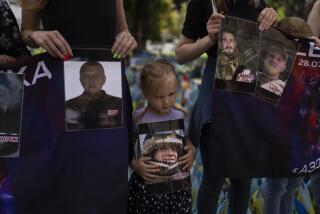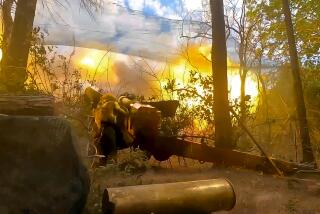Caught in Middle, a Chechen Haven Is Reduced to Rubble
- Share via
KATYR-YURT, Russia — During more than four months of war, this town of 10,000 people seemed to be one of the safest places in Chechnya. Russian troops encircled the community and controlled the roads leading in and out. As federal forces bombed the city of Grozny 22 miles to the east, refugees fleeing the destruction found a haven here.
But all that changed this month when a band of several hundred rebels arrived in Katyr-Yurt in the dead of night, dripping wet from wading through the icy Sunzha River to escape the Russian siege of Grozny, the Chechen capital.
The rebels told residents that they would stay only a few hours to dry their clothes. An hour later, the Russians began bombing and shelling the town. The intense bombardment lasted two days--ending long after the rebels had left carrying their dead and wounded.
Today, Katyr-Yurt is reduced to a smoking ruin. At least 170 civilians were killed in the assault, and dozens more may be entombed in the rubble, residents said. An estimated 80% of the town’s buildings were destroyed, and the rest are too severely damaged to be habitable. What were once trees are now mangled stumps. There is so much debris that it is hard to tell where the streets were.
Russian officials previously acknowledged that hundreds of civilians have died in the war. Chechens contend that the figure is far higher--perhaps tens of thousands. Already, the Chechens say, the fighting has caused more damage in towns and villages than resulted from the first Chechen war, which lasted from 1994 to 1996 and killed an estimated 80,000 people.
In this war, besides nearly leveling Grozny, the Russians, Chechens say, have destroyed about 40% of the towns and villages. The higher degree of devastation may result in part from the Russian military’s greater reliance on aerial bombing and artillery in an effort to keep its own casualty count down--despite the cost to civilians.
In Moscow, the Kremlin’s official spokesman on Chechnya, Sergei V. Yastrzhembsky, said Monday that he had no information about the events in Katyr-Yurt but would look into the matter.
The people of Katyr-Yurt were left to bury their dead, gather a few meager possessions and ask why the Russians demolished their town without a warning.
“I don’t understand it,” said Mutush Khamidov, 62. “Federal troops entered our village long ago. They had their positions all around us. There were a lot of Russian soldiers, and they were all well armed. Why did they let the rebels enter? Did they do it on purpose to destroy this town?”
In a case similar to the destruction of Katyr-Yurt, the Russian television network NTV reported Monday that federal forces recently attacked the Chechen town of Gekhi-Chu after retreating rebel fighters had stopped there to rest overnight. Once the rebels departed, residents said, Russian forces demolished hundreds of houses and killed at least five people, including a 3-year-old girl.
Among those who had found refuge in Katyr-Yurt was Matusa Batalova, 85, a Chechen woman who had served as a nurse for the Soviet army during World War II. A resident of Grozny, she fled with her daughter, traveling from town to town until she reached Katyr-Yurt.
“We were running and running away from the war, but it caught up with us here,” she said.
The trouble began Feb. 4, when the band of rebels arrived about 4 a.m.
When the bombing began, Batalova said, she and her daughter hid in a cellar with 18 other people. The noise of the bombing was so intense, she said, that they all temporarily went deaf.
“The earth shook and shook and shook, and it seemed it would never stop,” she said. “The house over us was demolished, and eight people in our basement died. They were sitting closer to the door and shielded us from death with their bodies. We would all have died because the ruins of the house trapped us. But other villagers cleared the rubble and saved us.
“For two days, they were bombing us, and then for two days we were burying the dead,” Batalova added.
When the bombing stopped Feb. 6, many of the residents fled toward the neighboring town of Atchkoi-Martan, said resident Salman Tukayev, 32, a farmer. But four miles down the road, Russian soldiers ordered them to stop. With nowhere to go, the townspeople--including children and the elderly--camped in a snowy field for two days until the soldiers finally let them pass.
“Until Feb. 4, the war seemed to be sparing us,” Tukayev said. “We were really happy. Not a single house was damaged. About 10,000 people lived here, and none of them wanted to leave. What’s more, a lot of refugees, relatives and friends from other places came here to hide from the war. It was considered to be about the safest place in Chechnya.”
Now the people remaining in Katyr-Yurt--only a handful--wonder if life will ever return to normal. The bombs not only destroyed their homes but killed most of their cattle, sheep and chickens--their principal source of food. It has even become dangerous to gather firewood in the forest because Russian helicopters flying overhead shoot at anything that moves.
The townspeople wonder why the bombing began so suddenly without a warning to civilians or an ultimatum to the rebels. They don’t understand why the Russians let the rebels enter the town in the first place.
Meanwhile, Russia’s military has closed off Grozny to returning civilians, saying Monday that mined buildings made living there too dangerous and that rebels might try to come back to the city in disguise, Associated Press reported. Itar-Tass news agency quoted commander Nikolai Zaitsev as saying the ban will last until March 1.
Special correspondent Nunayev reported from Katyr-Yurt and Times staff writer Paddock reported from Moscow. Sergei L. Loiko of The Times’ Moscow Bureau also contributed to this report.
More to Read
Sign up for Essential California
The most important California stories and recommendations in your inbox every morning.
You may occasionally receive promotional content from the Los Angeles Times.













